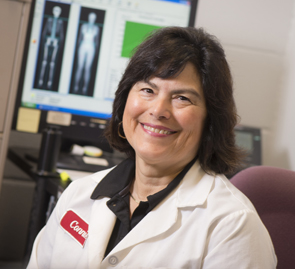Herbert Newby McCoy Award
Current McCoy Award Recipient
Connie Weaver – 2012 McCoy Award Recipient

Connie M. Weaver
Distinguished Professor and Head of the Department of Nutrition Science at Purdue
In 2011, Dr. Weaver was appointed to the Institute of Medicine's Food and Nutrition Board. The previous year she was elected to membership in the Institute of Medicine of the National Academies, of which she is a member of the Food and Nutrition Board. In 2008, she became deputy director of the National Institutes of Health-funded Indiana Clinical and Translational Science Institute. From 2000 to 2010, she was director of the NIH Purdue-UAB Botanical Research Center to study dietary supplements containing polyphenolics for age-related diseases.
Dr. Weaver is past president of the American Society for Nutrition. She is on the Board of Trustees of the International Life Sciences Institute and National Osteoporosis Foundation. She has published more than 260 research articles, and has trained 37 doctorate and 18 master's degree students.
Her honors include the Purdue outstanding teaching award (1985), Health Promotion Award for Women (1993) and the Sigma Xi Faculty Research Award (2006); the Institute of Food Technologists Babcock Hart Award (1997); the USDA A.O. Atwater Lecture Award (2003), the American Society for Nutrition Robert H. Herman Award (2009), the Natural Products Association's Burton Kallman Scientific Award (2010), and the Linus Pauling Research Prize (2011). Dr. Weaver was appointed to the 2005 Dietary Guidelines Advisory Committee for Americans.
LECTURE ABSTRACT
Calcium is one of four shortfall nutrients targeted by the Dietary Guidelines for Americans Advisory Committee that needs attention. The Weaver laboratory at Purdue quantified calcium intakes for optimizing bone accretion during puberty, a primary strategy to prevent osteoporosis later in life. These intakes have formed the basis for the recommended calcium intakes for North America, the Dietary Guidelines for Americans food patterns for dairy intake, and the Surgeon General's Report for Bone Health for adolescents. Professor Weaver's team uses controlled feeding studies and calcium tracers to determine the role of diet, sex, race, hormones and body size in building peak bone mass during adolescence. Her unique approach to addressing these questions has been the use of summer research camps called Camp Calcium to provide a controlled environment. Eleven camps have been conducted over 20 years. Another use of calcium tracers has been to screen interventions for reducing bone loss following menopause.
RESEARCH ACCOMPLISHMENTS
During my doctoral work, I studied accumulation of nuclear fission products by plants and methods of their removal by processing in an era of public safety concern over nuclear power plants. I learned isotopic tracer techniques and continued my studies of nutrition, food science, chemistry and plant physiology. When I arrived at Purdue in 1978, it was a natural transition to apply these techniques to the study of essential minerals.
With the 1980s came an awareness of the growing prevalence of osteoporosis and a possible role of diet and other lifestyle choices. However, there were scant quantitative data upon which to make dietary recommendations. Calcium was an obvious nutrient to study because it is the dominant mineral in bone and dietary intake is low.
We began using intrinsic labeling techniques to determine calcium absorption from common dietary sources including dairy products, plants and supplements, and worked with manufacturers to evaluate the potential for fortified foods. More recently, we have been studying dietary constituents that can enhance calcium absorption and the role of gut microbiota.
As half of adult bone mass is accumulated during adolescence, we designed Camp Calcium, a metabolic study environment run as a summer camp, to determine factors that influence bone accretion.
We determined optimal calcium intakes and learned that diet is as important as race, that boys are more efficient in using calcium than girls, that Asian girls are more efficient than blacks who are more efficient than whites, that increased body mass index increases calcium retention when calcium intakes are maximum, and that IGF-1 is the most important regulator of calcium utilization. Dietary calcium increases bone balance primarily through decreasing bone resorption.
As much bone can be lost following menopause as was gained in adolescence. The traditional approach to evaluating effective interventions requires years and a large number of volunteers. We developed a novel rapid screening method requiring few participants and short interventions.
Most of our work is done with multidisciplinary teams. This facilitates addressing complex questions and is more fun. This realization has led me to be involved in many multidisciplinary research ventures including the NIH Botanicals Research Center for Age Related Diseases, the Indiana Clinical and Translational Sciences Center, and the new Women's Global Health Initiative.

